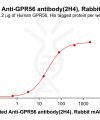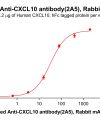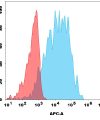
Figure 1. A) Flow cytometry data of serially titrated Rabbit anti-SIRPα monoclonal antibody (clone: DM8). The Y-axis represents the mean fluorescence intensity (MFI) while the X-axis represents the concentration of IgG used. B) Competition assay demonstrating DM8 blockade of CD47 binding to THP-1 cells. IC50=30.88ng/ml.






































